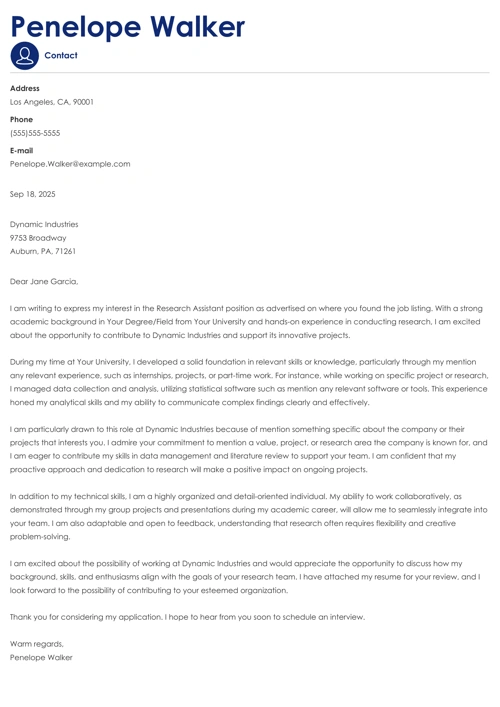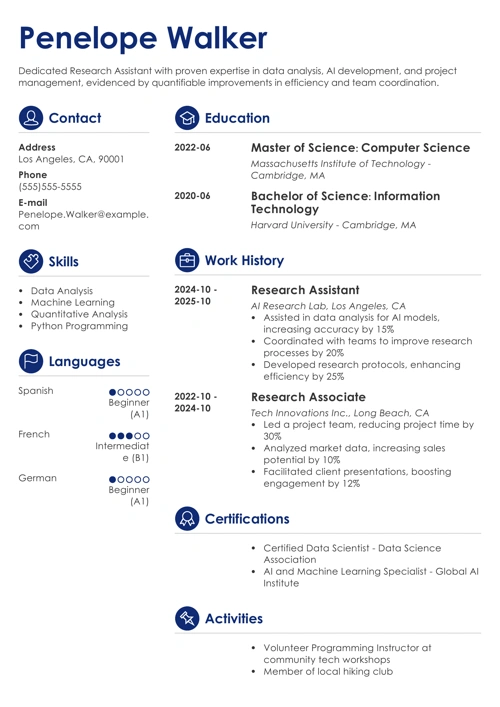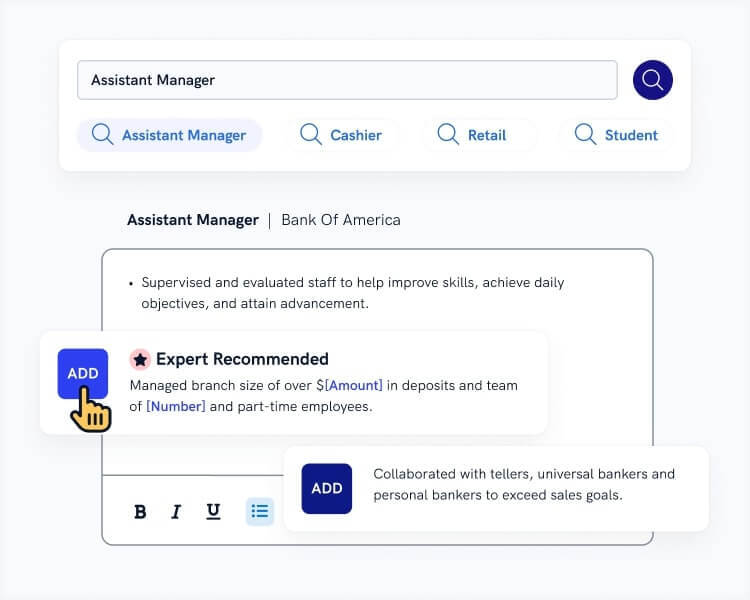Ready to concoct the perfect research assistant cover letter? You've got the lab skills and data-crunching expertise, but it's time to prove you're the missing variable in your dream job equation.
Let's design a cover letter that showcases your skills like a finely-tuned experiment, ensuring hiring managers can't resist offering you a spot in their lab.
This research assistant cover letter guide will show you:
- Research assistant cover letter examples better than 9 out of 10 others.
- How to write a perfect researcher cover letter principal investigators love.
- Tips on how to grab their attention with a professional research cover letter.
- How to sell yourself on a cover letter to get the research assistant jobs you want.
Want to write your cover letter fast? Use our cover letter builder. Choose from 20+ professional cover letter templates that match your resume. See actionable examples and get expert tips along the way.
Sample cover letter for a resume—See more cover letter samples and create your cover letter here.
Want to analyze your research assistant resume to be certain all’s in order? Here’s our guide on that: Research Assistant Resume: Sample & Complete Guide.
Considering similar positions too? See other cover letter examples for jobs in your industry:
- Academic Cover Letter Sample
- Graduate Assistantship Cover Letter Sample
- Academic Advisor Cover Letter Sample
- Editorial Assistant Cover Letter Sample
- Admissions Counselor Cover Letter Sample
- Education Cover Letter Sample
- Teacher Cover Letter Sample
- Teaching Assistant Cover Letter Sample
- Lab Technician Cover Letter Sample
- Librarian Cover Letter Sample
- Library Assistant Cover Letter Sample
- Cover Letter for Graduate School Sample
- Cover Letter for Scholarship Application Sample
- Cover Letter for an Architecture Internship Sample
- Cover Letter for Internship Sample
- Postdoc Cover Letter Sample
- Biology Cover Leter Sample
- Psychology Cover Letter Sample
- Formal Cover Letter Sample
- How to Write a Letter of Interest
Want to explore your options further? See our full selection of cover letter examples for every career: Best Cover Letter Examples.
And learn how to keep it short and sweet here: Short Cover Letter Examples for a Speedy Job Application
First, here’s our take on the perfect cover letter for research assistant jobs:
Research Assistant Cover Letter Sample
Henri Borges-Bonet
1234 35th St, #6
Astoria, NY 11106
March 1, 2019
Dr. Helena Bayer
Lead Researcher, Biology
Brown Building of Science
New York University
23-29 Washington Pl.
New York, NY 10003
Dear Dr. Bayer,
As a graduate school candidate in the field of biology, I was excited when you put out the call for undergraduate research assistants to join your team. My previous research assistant experience enabled me to develop my methodology, data analysis, and research techniques, and I am confident I have the necessary skills to be a great addition to your research team.
During my previous scientific research internship, I gained exposure to research in biosynthesis and gene editing. This valuable experience, coupled with my university training in molecular biology and bioinformatics, gives me a strong foundation with which to carry out the tasks of a biological research assistant.
A few of my proudest past achievements include:
- Implemented modification to a molecular tool to observe small molecules in vivo with 250% greater clarity and precision.
- Instituted new organization of bacterial strain library and organic extraction, which led to a 10% boost in research efficiency.
- Performed over 150 mouse surgeries, including stereotaxic injection and pre- and post-surgical care.
As my accomplishments hint, I am quite proud of the research I’ve undertaken, whether it’s intravital imaging experiments or immunoprecipitation assays. If granted the opportunity to join your scientific investigatory team, you can expect that same drive, focus, and attention to detail.
I would appreciate the chance to talk about your upcoming research projects and pitch to you how my past research internship experience makes me a great candidate now.
Sincerely,
Henri Borges-Bonet
P.S. If you’d be game for a kaffeeklatsch, I’d love to briefly go over how my molecular tool modifications which brought about the 250% boost in precision may be useful in your upcoming research studies.
How’s that?
Writing research cover letters which would earn you respect from Sheldon Cooper is not as difficult as it sounds (no Bazinga!). Read on to learn more!
Now, here’s how to write a cover letter for a research assistant position that will get you this job:
1. Pick the Best Format for a Research Assistant Cover Letter
Before you write a scientific research paper, you need to plan out the layout in an academically and intuitively sensical way.
Same here—
When you write a cover letter for research assistants, use a proper cover letter format to structure everything neatly and orderly.
Here’s a sample cover letter outline to follow like inclusion criteria:
Research Assistant Cover Letter Sample—Format Template
- Your address information and the date of writing
- The contact details of the lead researcher or supervisor
- An opening salutation (e.g., Dear Dr. Bayer,)
- An introduction that grabs their attention from the very beginning
- A paragraph on why you’re the perfect researcher for hire
- A paragraph on why this specific research project is right for you
- A closing paragraph with a powerful call to action
- A complimentary close (e.g., Sincerely) and your full name
- Optionally, a postscript (P.S.)
Keep your research position application letter to between 200–300 words, depending on your education level and trial experience.
To read more about choosing the best research assistant cover letter components, see this article: What to Include in a Cover Letter?
2. Start with a Research Assistant Cover Letter Intro They’ll Love
You like research, so here’s a bit for you:
- Clinical research assistants and laboratory technologists are projected to increase by 13% (over 42,000 jobs) between 2016 and 2026 in the US alone.
- Biochemist and biophysicist jobs, including university researchers, are expected to grow by 11% (3,600 jobs) between 2016 and 2026 in the US alone.
- Atmospheric scientists, including meteorologists and climate change researchers, are forecasted to increase by 12% (1,300) jobs between 2016 and 2026 in the US alone.
There’s more where that came from.
Whether you’re a researcher in biology, zoology, psychology, or any other -ology, there’s a lot of academic competition.
Stand out like an Elsevier awards recipient by opening your researcher cover letter the right way.
First, write a salutation which includes their name:
Research Assistant Cover Letters Examples—Salutation
| wrong |
|---|
| Dear sir or madam, |
| right |
|---|
| Dear Dr. Bayer, |
If it’s a formal role, such as in a university, stick to their last name. Don’t forget to acknowledge their professional title, either.
To find the head researcher’s name, check the university, clinical testing, or research facility website. If that doesn’t work, mosey on over to LinkedIn.
Can’t find their name at all?
Don’t worry.
Choose a neutral salutation, such as Dear Lead Researcher. That’s preferred over To whom it may concern.
Don’t care for Dear? Not able to find the lead researcher’s name? We’ve got other options for various scenarios: How to Start a Cover Letter: Sample & Guide [20+ Examples]
Now, you’re opening lines.
Like a great chemistry researcher, you’ve got all the solutions.
So—
Show them that from the get-go with a compelling introductory statement:
Cover Letter for Research Scientist Jobs Examples—Introduction
| wrong |
|---|
| My name is Henri, and I’m applying for the position you posted online. I think I would be an excellent candidate, and I have all the skills and experience the job requires. |
| right |
|---|
| As a graduate school candidate in the field of molecular biology, I was excited when you put out a call for undergraduate research assistants to join your team. My previous scientific research experience helped me to develop my methodology, data analysis, and research techniques, and I am confident I have the necessary skills to be a great addition to your research team. |
The first one is like conducting an experiment without a control group—
You’ll get shot down quick.
The second one, however, shows enthusiasm, confidence you have the required skills, and an alluring peek into your research background and experience.
It’s sure to run benzene rings around the other candidates!
Pro Tip: A generic cover letter is a no-no for any job, but most certainly for the role of a research assistant. Tailor your cover letter by matching your skills and know-how to the specific researcher responsibilities and requirements.
There are other ways to go about your research technician cover letter introduction statement. For more ideas, see: How to Write a Cover Letter: Sample & Guide [20+ Examples]
3. Write a Great Middle for Your Cover Letter for Research Assistants or Internships
The core. The body paragraphs. The nucleus.
However you refer to it, these middle bits are crucial to get right on a research assistant cover letter.
Don’t, and the only adverse events you’ll be a part of will involve your professional career.
Use 2–3 paragraphs to include these key research assistant cover letter necessities:
- Explain why you’re the best research assistant candidate.
- Give numbered accomplishments to verify proud past wins.
- Demonstrate the research skills you have match their requirements.
- Make it evident this is the research job of your dreams.
Here’s a sample biological research cover letter sample body:
Cover Letter for Research Position Undergraduate Example—Body
During my previous scientific research internship, I gained exposure to research in biosynthesis and gene editing. This experience, coupled with my university training in molecular biology and bioinformatics, gives me a strong foundation with which to carry out the tasks of the biological research assistant.
A few of my proudest past achievements include:
- Implemented modification to a molecular tool to observe small molecules in vivo with 250% greater clarity and precision.
- Instituted new organization of bacterial strain library and organic extraction, which led to a 10% boost in research efficiency.
- Performed over 150 mouse surgeries, including stereotaxic injection and pre- and post-surgical care.
As my accomplishments hint, I am quite proud of the research I’ve undertaken, whether it’s intravital imaging experiments or immunoprecipitation assays. If granted the opportunity to join your research team, you can expect that same drive, focus, and attention to detail.
Well, what do you think?
This body section for a research assistant cover letter is only three paragraphs long.
However, it packs a punch by stuffing it with just the essentials: quantifiable achievements, insight into your research background, and a show of desire to join the team—no filler or fluff.
Strong as a covalent bond!
Pro Tip: Use keywords on your cover letter for research assistants, just as you used on your research assistant resume. Choose the best fonts to make it easy for research fellows and lead investigators to read.
Need more ideas on how to tweak the body area? Maybe research assistant cover letter no experience examples? We’ve got all the cover letter dos and don’ts here: 35+ Professional Cover Letter Tips and Advice
4. Close Your Research Assistant Cover Letter Like a Successful Debrief
Most behavioral science studies require a signed post-debrief consent form for each participant to properly close them out.
It’s similar here—
Whether it’s a clinical research coordinator cover letter or an entry-level research internship cover letter, end it right with a solid closing statement.
Here are two examples of research assistant cover letter endings:
Cover Letter for Undergraduate Research Assistant Examples—Closing Paragraph
| wrong |
|---|
| I look forward to your reply. |
| right |
|---|
| I would appreciate the chance to talk about your upcoming research projects and pitch to you how my past research internship experience makes me a great candidate now. |
The first one is curt and emotionless—
It puts the ass in research assistant.
The second one, though, neatly ties the rest of the cover letter together.
Pure efficacy.
Next—
A valediction (closing sentiment) and your full name:
Sample Cover Letter Research Assistant—Valediction
Sincerely,
Henri Borges-Bonet
Lastly, the postscript.
While a P.S. below your signature isn’t required, it’s a great hack to grab the principal investigator’s attention once more.
Here’s an example P.S. for a clinical research assistant cover letter:
Research Assistant Cover Letter Sample—Postscript
P.S. If you’d be game for a kaffeeklatsch, I’d love to briefly go over how molecular tool modifications which brought about the 250% boost in clarity may be useful in your upcoming research studies.
See that?
This postscript adds some humanity to any sociological research or clinical research cover letter.
It also reminds them of your greatness by bringing up a key win once again.
Now, you’re a strong contender for the research position!
Pro Tip: Writing a cover letter for research internships or one with no experience? Follow the same instructions here, but tweaked and tailored to your role. On an entry-level or research assistant internship cover letter, study the job description and highlight transferable skills.
Looking for more ideas on how to close out a research cover letter? We’ve a great guide right here: How to End a Cover Letter: Sample & Complete Guide [+20 Examples]
Creating a resume with our builder is incredibly simple. Choose a resume template and follow our step-by-step guidance to have a professional resume ready in minutes.
When you’re done, our AI resume builder will score your resume and our resume scanner will show you exactly how to improve it.
Key Takeaway
Now you have an research assistant cover letter that deserves a Humboldt Prize, and it’s nowhere near as arduous as a longitudinal clinical trial.
Let’s wrap it up.
Here’s how to write the perfect cover letter for research assistant jobs:
- Format your RA or CRA cover letter so that it’s accessible and logical.
- Open with a compelling intro statement for a good head start.
- Summarize your background and experience in a relevant manner.
- Highlight a few past accomplishments using numbers.
- Show your enthusiasm for the project, research topic, and investigator.
- Close it off with a powerful ending statement and call to action
- Consider adding a postscript for one last chance to wow them.
Now THAT’S a research assistant cover letter hot enough to denature any protein!
About Zety’s Editorial Process
This article has been reviewed by our editorial team to make sure it follows Zety's editorial guidelines. We’re committed to sharing our expertise and giving you trustworthy career advice tailored to your needs. High-quality content is what brings over 40 million readers to our site every year. But we don't stop there. Our team conducts original research to understand the job market better, and we pride ourselves on being quoted by top universities and prime media outlets from around the world.



